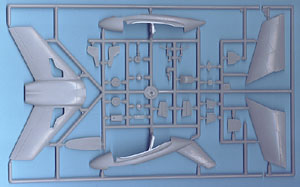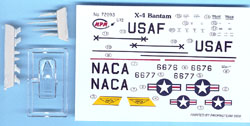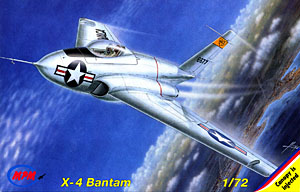MPM’s 1/72 Northrop
X-4 Bantam By Jim Schubert | | History This little bird conceived in early 1946 and first flown December 15, 1948, was officially the XS-4 "Skylancer", but was more commonly known as the "Bantam"; a neat little sports-car of an airplane according to the pilots who flew it. The "S" was dropped from the model number in early 1948. The X-4 was designed to study stability and control of the semi-tailless configuration in the transonic speed range with a Vne of Mach 0.9. Some pilots claimed Mach 1.0 in a dive, but this is unlikely. Two were built, serials 46-676 and 46-677 and flew regularly without accident for about ten years. Both survive; 6676 is on display at the Air Force Academy in Colorado Springs and 6677 is on display at the USAF Museum in Dayton, where I studied and photographed it during the 1997 IPMS/USA National Convention in nearby Columbus. The Kit Like the Sword Staggerwing, this kit comes in a cheap, flimsy end-opening box. I do wish they'd add a dollar to the price of each kit and put it in a stout top opening box ala Hasegawa, Tamiya, etc. The fine box art shows 6677 in its NACA days. The fine Propagteam decal sheet and the instructions provide two color and marking schemes for 6677 and one for 6676. The box art scheme for 6677 can also be  done with the decals. The instruction sheet's second scheme for 6677 features lots of red. I view this with skepticism, as I do any scheme, unless I can confirm it from other sources. None of the references cited below show this "red" scheme. The instructions, on both sides of two A-4 sheets folded to create an eight-page guide, are quite good including a history, a parts map, assembly instructions and the three-color schemes noted. done with the decals. The instruction sheet's second scheme for 6677 features lots of red. I view this with skepticism, as I do any scheme, unless I can confirm it from other sources. None of the references cited below show this "red" scheme. The instructions, on both sides of two A-4 sheets folded to create an eight-page guide, are quite good including a history, a parts map, assembly instructions and the three-color schemes noted. Do you remember your first MPM kit? Compare the current crop with that first one. They have come a long way in quality, accuracy and presentation. They're close to the leading manufacturers now; and they do subjects the "Big Boys" could never afford to do. If they'd fix that damned box problem, they'd be right up there with the industry leaders! The kit has 27 gray plastic parts on one sprue tree, one very well done injection-molded clear bubble canopy and 10 small resin parts. The injected canopy includes part of the top deck of the fuselage, as did the original so that, if you wish, you can open the canopy to display the interior. Beware if you opt to do this you must replace the generic WWII bucket seat with a late '40s vintage ejection seat. I'd use True Details', p/n TD72405, F-80/T-33 seat. Have you ever noticed that regardless of the vintage of the subject of any Czech plastic airplane kit, the same generic bucket seat is used? I sometimes suspect there is really only one manufacturer of plastic kits in the Czech Republic, but that for some reason they use  a dozen different brand names in the market. Wheels and landing gear struts are other items that seem to come in a limited number of generic varieties. I'll use the kit's main gear struts, but I'll go to the spares box for main wheels. I'll add the anti-torque scissors to all three landing gear legs and brake lines to the main gear. Only one part in the review sample has a flaw, a small depression in the left side of the fin. It's clearly not a sink mark; it looks like the part was dented after it left the mold. The panel lines are finely scribed. The two part forward nose gear doors are too lightly scribed though and will need "chasing" with your favorite scriber. You should consider detailing the intake trunks feeding the two Westinghouse XJ-30 turbo-jet engines and either opening up the tailpipes or replacing them with tubing the wall thickness of which you have reduced. You should also consider boxing in and detailing the main wheel wells. a dozen different brand names in the market. Wheels and landing gear struts are other items that seem to come in a limited number of generic varieties. I'll use the kit's main gear struts, but I'll go to the spares box for main wheels. I'll add the anti-torque scissors to all three landing gear legs and brake lines to the main gear. Only one part in the review sample has a flaw, a small depression in the left side of the fin. It's clearly not a sink mark; it looks like the part was dented after it left the mold. The panel lines are finely scribed. The two part forward nose gear doors are too lightly scribed though and will need "chasing" with your favorite scriber. You should consider detailing the intake trunks feeding the two Westinghouse XJ-30 turbo-jet engines and either opening up the tailpipes or replacing them with tubing the wall thickness of which you have reduced. You should also consider boxing in and detailing the main wheel wells. These airplanes were/are painted a very pale, neutral, gray overall; about the same shade as the early P-80s. Color photos appear to show the cockpit to be the same gray as the exterior with black instrument panels and consoles. I would presume the wheel wells to be in Zinc-Chromate Green primer, which was pretty standard for the time. The opening cockpit hood is outlined yellow; which fact is not noted in the instructions. Conclusion This is a very nice kit of a very pretty little airplane. I am anxious to start work on mine; I've been researching it for some time anticipating starting the pretty poor old Czechmaster resin kit, which has now been consigned to the spares box. Congratulations to MPM on their latest issue. Now how about a similarly nice kit for the Bell X-1A/B/C/D? References -
Northrop - An Aeronautical History: Fred Anderson, Northrop, Century City, CA, 1976, Library of Congress # 76-22294. -
The X - Planes: Jay Miller (Sorry I don't have the other publication details to hand.) -
The Flying Wings Of Jack Northrop: Pape, Campbell & Campbell, Schiffer, Atglen, PA, 1994, ISBN: 088740-597-5. -
Northrop Flying Wings: Ed Maloney, WWII Publications, Corona Del mar, CA, 1975, ISBN: 0-915464-00-4 | 









    |

 done with the decals. The instruction sheet's second scheme for 6677 features lots of red. I view this with skepticism, as I do any scheme, unless I can confirm it from other sources. None of the references cited below show this "red" scheme. The instructions, on both sides of two A-4 sheets folded to create an eight-page guide, are quite good including a history, a parts map, assembly instructions and the three-color schemes noted.
done with the decals. The instruction sheet's second scheme for 6677 features lots of red. I view this with skepticism, as I do any scheme, unless I can confirm it from other sources. None of the references cited below show this "red" scheme. The instructions, on both sides of two A-4 sheets folded to create an eight-page guide, are quite good including a history, a parts map, assembly instructions and the three-color schemes noted. a dozen different brand names in the market. Wheels and landing gear struts are other items that seem to come in a limited number of generic varieties. I'll use the kit's main gear struts, but I'll go to the spares box for main wheels. I'll add the anti-torque scissors to all three landing gear legs and brake lines to the main gear. Only one part in the review sample has a flaw, a small depression in the left side of the fin. It's clearly not a sink mark; it looks like the part was dented after it left the mold. The panel lines are finely scribed. The two part forward nose gear doors are too lightly scribed though and will need "chasing" with your favorite scriber. You should consider detailing the intake trunks feeding the two Westinghouse XJ-30 turbo-jet engines and either opening up the tailpipes or replacing them with tubing the wall thickness of which you have reduced. You should also consider boxing in and detailing the main wheel wells.
a dozen different brand names in the market. Wheels and landing gear struts are other items that seem to come in a limited number of generic varieties. I'll use the kit's main gear struts, but I'll go to the spares box for main wheels. I'll add the anti-torque scissors to all three landing gear legs and brake lines to the main gear. Only one part in the review sample has a flaw, a small depression in the left side of the fin. It's clearly not a sink mark; it looks like the part was dented after it left the mold. The panel lines are finely scribed. The two part forward nose gear doors are too lightly scribed though and will need "chasing" with your favorite scriber. You should consider detailing the intake trunks feeding the two Westinghouse XJ-30 turbo-jet engines and either opening up the tailpipes or replacing them with tubing the wall thickness of which you have reduced. You should also consider boxing in and detailing the main wheel wells.







